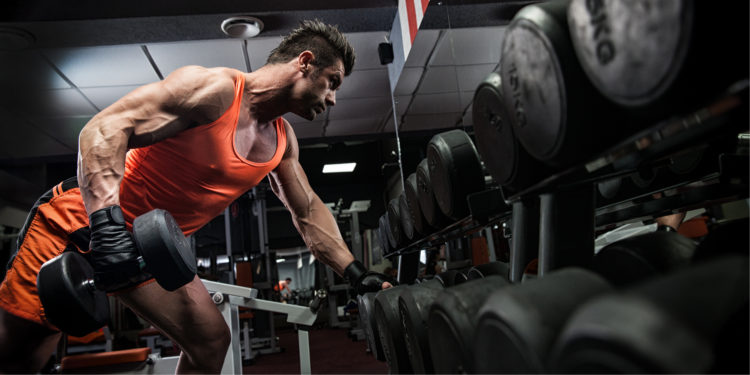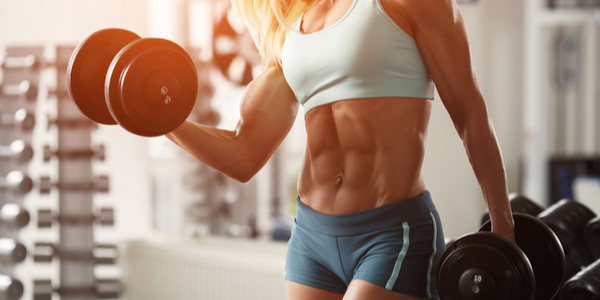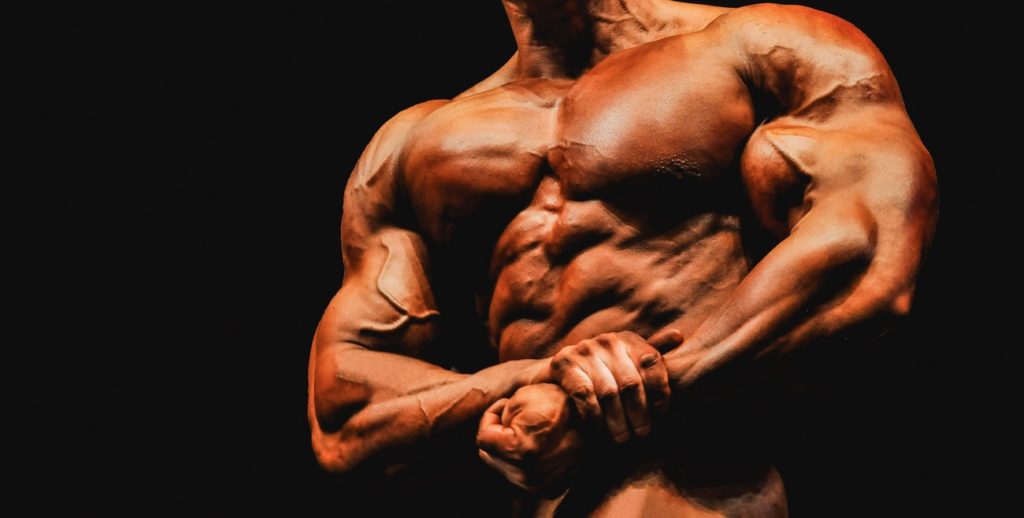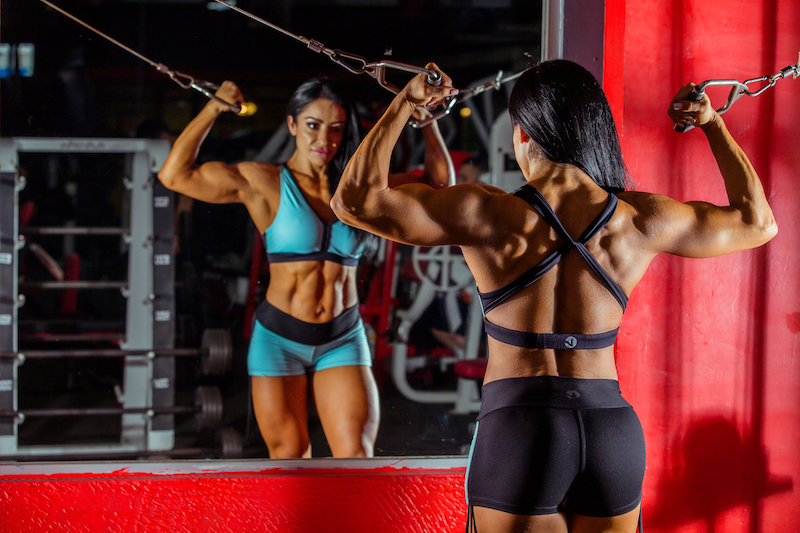Editor’s note: The content on BarBend is meant to be informative in nature, but it should not be taken as medical advice. The opinions and articles on this site are not intended for use as diagnosis, prevention, and/or treatment of health problems. If you’re dealing with or exhibiting signs of depression, please seek the advice of a medical professional immediately.
If you’re reading this, then chances are you’ve secretly (or not so secretly — I’ve seen you at the gym) done some type of muscle-making pose in the mirror and contemplated if your muscles are big enough, and defined enough.
It’s natural for gym-goers who want to build muscle mass to check progress, both physically in terms of how much we can lift and aesthetically, in terms of how our clothes fit and how much our traps pop in the selfies we definitely don’t take. But there’s a fine line between enjoying the changes to our physiques and needing changes to our physiques — muscle dysmorphia.

What Exactly Is Muscle Dysmorphia?
Generally, dysmorphia refers to an inability to look in the mirror and see the shape of your body accurately. And according to the Body Dysmorphic Disorder Foundation, muscle dysmorphia (MD) is characterized by an intense preoccupation with looking “too puny” or “not muscular enough” that can be accompanied by compulsive checking one’s own body and/or constantly comparing your muscles to other people’s.
Panicking over being unable to complete a workout, overtraining even when injured or exhausted, substance misuse such as excessive supplementation or steroid abuse, and disordered eating can all be symptoms of muscle dysmorphia.
The DSM-5 And Muscle Dysmorphia
The DSM-5 classifies muscle dysmorphia as a class of obsessive-compulsive disorders, characterized by the following:
“Preoccupation with one or more perceived defects or flaws in physical appearance that are not observable or appear slight to others.
At some point during the course of the disorder, the individual has performed repetitive behaviors (e.g., mirror checking, excessive grooming, skin picking, reassurance seeking) or mental acts (e.g., comparing his or her appearance with that of others) in response to the appearance concerns.
The preoccupation causes clinically significant distress or impairment in social, occupational or other areas of functioning. The appearance preoccupation is not better explained by concerns with body fat or weight in an individual whose symptoms meet diagnostic criteria for an eating disorder.
With muscle dysmorphia: The individual is preoccupied with the idea that his or her body build is too small or insufficiently muscular. This specifier is used even if the individual is preoccupied with other body areas, which is often the case.”

The manual goes on to advise doctors to evaluate how much self-awareness people have about their muscle dysmorphia, stating that physicians should:
“Indicate degree of insight regarding body dysmorphic disorder beliefs (e.g., “I look ugly” or “I look deformed”).
- With good or fair insight: The individual recognizes that the body dysmorphic disorder beliefs are definitely or probably not true or that they may or may not be true.
- With poor insight: The individual thinks that the body dysmorphic beliefs are probably true.
- With absent insight/delusional beliefs: The individual is completely convinced that the body dysmorphic beliefs are true.”
In plain English, all of this means that serious lifters as a whole are often preoccupied with our muscle size and appearance: but there is a fine line over which our typically healthy lifting can feed a potentially dangerous and need to improve our bodies, even with risky means.
What Do Experts Say?
Lachlan Mitchell, lead author of a 2017 study on muscle dysmorphia in bodybuilders published in the journal Sports Medicine, tells BarBend that bodybuilding can be a blessing, a curse, or both for people who are predisposed to experiencing muscle dysmorphia (1). His 2017 study found a correlation between bodybuilders with muscle dysmorphia who also experienced depression, anxiety, neuroticism, and perfectionism.

Of course, not all bodybuilders with depression experience muscle dysphoria, but Mitchell says that “under the right circumstances, meaning a competitive environment, training, focus on nutrition, body composition, these individuals who demonstrate other psychological factors (depression, anxiety, self-esteem) may manifest muscle dysmorphia characteristics.”
However, experts are quick to point out that bodybuilding itself is not necessarily a dangerous endeavor. Lead author of another 2017 study on muscle dysmorphia, this one published in the journal Psychiatry Research, (2) Claudio Longobardi, tells BarBend that,
“We do not consider bodybuilding to be a dangerous practice for the psychological well-being of individuals.”
However, he notes that bodybuilding and its pursuit of increased muscularity is associated heavily with masculinity in present-day United States culture. Therefore, he says that,
“Bodybuilding could be the path some individuals take to try to make up for some psychological needs related, for example, to the fear of being rejected or due to a sense of insecurity/danger.”
Because of the association between toxic masculinity and muscle dysmorphia, both researchers say that women are an under-studied population when it comes to the relationship between dysmorphia and bodybuilding. Nonbinary people and trans folks, too, are vastly understudied in this regard, though it’s important to point out that transmasculine people perceiving ourselves as “not muscular enough” is one crucial way that gender dysphoria and muscle dysmorphia can intersect.
How Do You Know If You’re Just A Serious Bodybuilder, Or If Something Dangerous Is Happening?
Among more experienced bodybuilders, Mitchell points out, muscle dysmorphia is actually less common than it is in novice bodybuilders. (3) While researchers remain unsure of exactly the reasons for this, Mitchell posits that “it could be that those who show signs of MD are not fulfilled by the sport, and drop out, or that staying in the sport long term brings a more leveled approach, reducing signs and symptoms.”
Still, he points out that those at high risk for dysmorphia — who already experience depression, anxiety, and tend toward perfectionism and neuroticism — may be drawn to bodybuilding at first, and may find that atmosphere conducive to their growing dysmorphia. “Given the nature of bodybuilding competition and preparation (diet, exercise, very rigid, physique focused),” Mitchell says, “it is not unreasonable to see how those who may be at risk of MD could begin to demonstrate MD features when exposed to this bodybuilding environment.”
Ultimately, even with all the discipline that bodybuilding requires, it should make you feel good and confident more often than it makes you feel…well, crappy. Longobardi tells BarBend, that muscle dysmorphia — as compared to healthy bodybuilding — can
“have a negative impact on social, scholastic or work functioning, and often also negatively interfere with sentimental and friendship relationships.”
In addition,” he says, “MD symptoms are associated with psychological symptoms, high distress and unhealthy behaviors that increase mental suffering. The feeling of always feeling inadequate, and not being persuaded by assurances about one’s physical appearance from peers can be an indication that the bodybuilders might listen. More evident, the feeling of feeling guilty when you miss a workout and the feelings of feeling “obligated” to train are pieces of evidence that line is being crossed.”
Mitchell also says that bodybuilders should watch for fine distinctions between their training and their entire lives. “There is a difference between someone being very measured with their diet and training, and someone who focuses on nothing but their diet and training,” he tells BarBend. He goes on to advise athletes and trainers alike to look for other signs of possible muscle dysmorphia, such as training when injured, spending time in the gym beyond what is typically required of the sport, and consistently backing out of social interactions to focus on their diet and training.
You Can Get Help And Keep Training
Mitchell and Longobardi both suggest that social support is key to recovering from muscle dysmorphia, but rest assured: this does not mean that you have to put a full stop on your favorite sport. “The best recommendation is to go to a psychologist, possibly specialized in body image disorders or sports psychology,” Longobardi says. “Overcoming muscle dysfunction does not coincide with a low-quality sports experience or with lower results in agonistic competitions.”
In other words, you can recover from your muscle dysmorphia and — under the supervision of a knowledgeable psychologist and with a solid support system in place — you can still pursue the sport you love.
References
1. Mitchell L, e. (2020). Muscle Dysmorphia Symptomatology and Associated Psychological Features in Bodybuilders and Non-Bodybuilder Resistance Trainers: A Systematic Review… – PubMed – NCBI . Ncbi.nlm.nih.gov. Retrieved 2 January 2020, from https://www.ncbi.nlm.nih.gov/pubmed/27245060
2. Longobardi C, e. (2020). Muscle dysmorphia and psychopathology: Findings from an Italian sample of male bodybuilders. – PubMed – NCBI . Ncbi.nlm.nih.gov. Retrieved 2 January 2020, from https://www.ncbi.nlm.nih.gov/pubmed/28646788
3. Mitchell L, e. (2020). Correlates of muscle dysmorphia symptomatology in natural bodybuilders: Distinguishing factors in the pursuit of hyper-muscularity. – PubMed – NCBI . Ncbi.nlm.nih.gov. Retrieved 2 January 2020, from https://www.ncbi.nlm.nih.gov/pubmed/28535445
Feature image from sportoakimirka/Shutterstock
